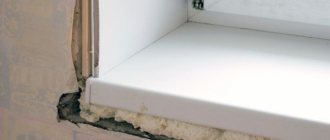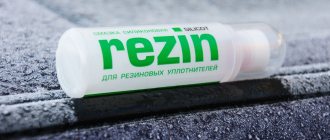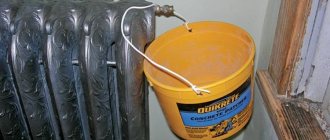With the onset of cold weather, a thrifty owner strives to escape the cold without causing significant damage to the family budget. Let's look at how to seal old wooden windows for the winter. All methods are aimed at doing it yourself at home using improvised means and inexpensive insulation materials.
According to thermal photographs of houses, a significant part of the heat leaves the room through walls, windows, doors, and roof. Insulating these units allows you to increase the heat-saving properties of the house. However, complete insulation is an expensive task, plus it is not always possible to do it yourself.
But sealing the windows for the winter is a relatively simple and easy-to-implement measure that anyone can do, and the effect is confirmed by an increase in the room temperature by 2-4 °C, depending on the chosen method of insulation.
Materials for insulating windows for the winter
10 ways to seal your windows for the winter
Summarizing the experience of previous generations, you can write an entire encyclopedia on the topic: how to seal the windows to prevent the draft.
Let's consider proven and affordable methods of insulation, for ease of comparison, arranging them in the form of a rating, in ascending order of the cost of performing the work:
Window paper
More precisely, paper putty. This is the cheapest method, since all you need to seal the windows is a selection of old newspapers and water. To increase the effectiveness of the putty, you can add 2 parts of crushed chalk or 1 part of clay to it. The resulting mass is highly plastic, which makes it easy to seal even the smallest cracks. The window can be easily washed off the putty during operation (as long as it remains wet). Insulating windows with paper is an effective way, but only for one season; in addition, a covered window does not make it possible to open the sashes in winter. As the weather gets warmer, the putty is removed from the cracks and the window is washed.
Cost : 0 rub.
Pros : free and simple.
Disadvantages : the need to repeat the work annually, there is no way to open a sealed window, it is not aesthetically pleasing and the presence of additional decor in the form of gluing paper or fabric strips.
Gaps between frame and slopes
These elements are in contact with each other, and the tightness of the structure as a whole depends on these joints.
The main causes of defects are:
- violation of installation rules - uneven alignment, deviation of elements from the overall structure due to compression or expansion under the influence of temperatures;
- poor sealing of the space between the wall and the frame - it should be remembered that the foam is not resistant to the sun, humidity from the street, so it needs to be puttied and painted;
- no gap for thermal expansion or zero installation gap.
If a crack appears, but there is no opportunity to invite a specialist, then you can make the repair yourself. You will need tools, materials, and instructions. The most effective repair methods in this situation are:
- A temporary measure is sealing without dismantling the structure. This action is considered temporary, since the main cause cannot be identified. The defect is simply masked.
- A reliable and durable method is to disassemble the structure and identify the causes. But only professionals can do this.
Paper tape or fabric strip
The fastest way to eliminate a draft. You can’t count on significant insulation, but the work can be done quickly and at minimal cost.
Approximate price : 100-130 rubles/roll, strips of fabric (used material).
Advantages : cheap, high speed;
Disadvantages : minimal efficiency, tape peeling off in a draft.
How to seal windows with soap and paper (toilet) - video
Repairing small cracks
If small cracks are discovered, then the owners have to take action immediately. There are several main ways to eliminate them from the inside.
Paper, clay, chalk
To create paper putty, you need to shred paper—newspaper works best. They are soaked in water, part of clay and two parts of powdered chalk are added. All gaps are sealed with the resulting composition.
For protection, window tape or special adhesive paper is glued on top, or fabric strips pre-lubricated with soap can be used.
Such insulation will be simple but reliable protection before the onset of warming, but afterwards there will be unsightly stripes that will need to be washed.
cotton wool
The process of insulating aged wooden windows can be carried out with cotton wool and fabric. Cotton wool is a unique alternative to paper and newspapers. Technical wool is pushed into the cracks, sealed on top with heavily soaped strips of fabric.
This method is used more often and is quite inexpensive to implement. You can replace the fabric with modern heat-insulating tapes, which, after removal, will not spoil the paint.
Sealant
Silicone sealant for wooden frames is rarely used. In severe frost it will quickly lose its properties, so with the onset of warmer weather the procedure will have to be repeated.
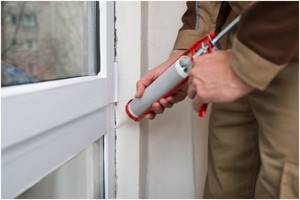
Working with sealant
Putty
This method has come down to us since Soviet times. It was almost the only effective method for maintaining heat. Modern putty can also guarantee protection against drafts. It is used to seal the areas where the frame meets the wall. A special window composition or ordinary plasticine is used.
Materials are applied from the outside of the window - into the joints. First, small pieces are kneaded with your fingers, forming thin sausages and recessing them into the gaps.
Polyethylene
This is one of the most accessible and easiest ways. Polyethylene has the following advantages:
- low price;
- ease of installation;
- ease of care.
But its disadvantages should be especially noted, namely:
- insufficient thermal insulation;
- a lot of dust sticks to it.
The film is attached in the following sequence:
- Measure the required length of material according to the size of the window.
- Preparing the frame.
- Fasten the film with tape or pushpins; there should be no gaps left so that warm air does not penetrate.
Foam rubber
Foam rubber is a suitable material for thermal insulation of large gaps.
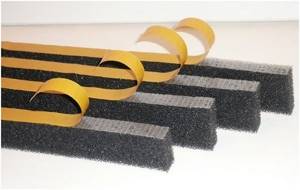
Special foam rubber
Sometimes wooden window sashes become so dry that they no longer fit tightly to the frame. But using only technical wool will not help. For insulation, foam rubber is glued around the entire perimeter. Thanks to it, the joints become airtight when closed.
Special foam rubber has an adhesive layer on one side. When such materials were not commercially available, foam rubber was attached using the smallest nails. With proper use, the product can serve for 3 years, but then deformation occurs. It is better to seal the top of the strip with tape. In the spring, the tape is removed, and the foam rubber can be left in its place.
Thermal reflective film
The use of heat-reflecting film is a modern method of eliminating cold bridges. The principle of operation of the material is based on the fact that it allows light to enter the house, and infrared radiation does not escape outside, thus retaining heat in the rooms.
The membrane has two parts - two sides. One is shiny, the other is ordinary. The main thing is to make sure that the shiny side faces the street.
The film is overlapped onto the frames with tape. When placed correctly and carefully, the thermal insulation is not noticeable. The membrane is suitable for PVC windows.
Rubber compressor
Rubber is used to create two types of belts:
- sealing;
- self-adhesive.
Self-adhesive material is used more often; it is made from synthetic rubber, therefore it has all its advantages:
- elasticity;
- resistance to temperature changes;
- resistance to aggressive environments;
- long-term operation.
Cotton wool or foam rubber for windows
Technical wool is cheaper, but it is sold in large quantities.
Using cotton wool or foam rubber, you can seal large gaps, for example, between window sashes or a sash and a wall or window sill. The cotton wool/foam rubber must be sealed on top with paper tape or special tape, because It is difficult to seal small cracks with cotton wool. In this case, the paper tape will serve not only a decorative function, but also increase the efficiency of insulation.
Average cost : cotton wool (50 rubles/200 g), foam rubber (30-35 rubles/skein).
Advantage : simplicity and lack of wet work.
Disadvantages : the cost of insulation increases (+ the price of cotton wool or foam rubber), additional finishing of the insulated seam is required. In addition: cotton wool and foam rubber absorb moisture, the work must be repeated annually, and a sealed window cannot be opened for ventilation.
How to cover windows with newspaper for the winter - video
Preventing heat loss through other places
To ensure a comfortable temperature in the apartment, it is necessary to insulate not only the windows, but also the window sills and slopes, as well as the seams of the balcony.
As with gluing wooden windows, paper, fabric strips, paper tape, foam rubber, etc. are used to insulate balcony blocks. You can stick a special film on the glass of the balcony door.
It will be more difficult with slopes and window sills, especially with regard to plastic products. Gaps often remain during the installation process. Installers put cement or even garbage in them. In some cases, polyurethane foam is poured there. This is very inconvenient, because over time it can shrink and let cold into the room.
Windowsill
The method of insulating a window sill is quite simple. You need to remove the old foam and fill in the new one. Cracks formed in it can be eliminated using silicone sealant. Next, plaster and paint or any other decorative coating are applied.
Slopes
Slopes of plastic structures can be insulated using the same technology as in the case of wooden ones. For maximum efficiency, you can glue foam plastic to the wall using special glue and then apply plaster, putty and paint.
Sealing up windows is not difficult, so you can do it yourself. When it comes to insulating slopes and window sills, sometimes you need to turn to the services of craftsmen.
Self-adhesive foam for windows
A more technologically advanced way to seal windows and combat drafts. This method is good because it allows you to do without sealing the cracks with paper or fabric strips. Due to the presence of adhesive (adhesive) tape on the foam rubber insulation, it can be glued to the inside of the window sashes.
Approximate cost : 60-75 rub./roll.
Pros : the window can be used as usual.
Cons : after gluing, the insulation can prevent the window from closing; foam insulation is non-hygroscopic and is not protected in any way. If the sashes fit tightly to the frame, you need to either saw down (cut, adjust) part of the wood, or choose other methods of insulation. If the gaps are large, you will have to decide what can be used to seal wooden windows besides this material.

Foam rubber for windows with an adhesive layer (foam rubber seal)
Why seal your windows every year?
Old wooden windows are made from solid timber, which does not hold its shape, dries out, swells and warps.
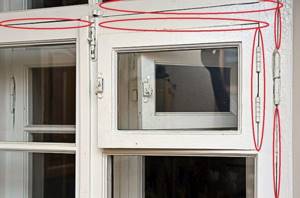
Photo: up to 25 m3 per hour easily passes through the gaps in the old window (highlighted in red). By the way, this amount of incoming air is taken into account when calculating the operation of the hood in old high-rise buildings. But in winter it is cold air and you want to reduce its intake. However, the problem of ventilation lies not only in the old woodwork. Some plastic windows are not inferior to them in this and blow out so much that the curtains move. I think the owners of apartments in new buildings understand what I'm talking about. Windows from the developer are in most cases an economical option, made from the simplest profile, thin reinforcement, cheap sealant, and any kind of fittings. Here we save on everything. The consequences are predictable - blowing.
Over time, high-quality plastic windows can also leak - this problem appears in windows installed 20-25 years ago. The seal begins to dry out, the fitting settings are lost, and the window begins to gradually leak.
How to deal with blowing depends on the reason for its occurrence. For old carpentry these are one event, and for plastic windows another.
Self-adhesive window seal
Most owners of old wooden windows prefer this type because of the optimal price/effect combination. The rubber seal is glued to the inside of the window sash. Due to the fact that the seal is hollow, it does not create problems when closing the sash. It adheres well to the frame due to the adhesive strip, which opens when glued. The seal lasts 1-2 years.
Average price : 84-100 rub./roll.
Advantage : longer service life, window operation mode is not affected, aesthetics.
Disadvantages : cost, labor intensity, you can install a low-quality seal (many fakes), the likelihood of the seal coming off the frame.
Causes
Having noticed the windows blowing, you should understand the causes of the problem. Having found out the reason, it is worth thinking about eliminating it.
Poor quality installation
Violation of installation rules often leads to thermal insulation problems. As a rule, blowing occurs as a result of self-installation of window structures.
House shrinkage
When the house shrinks, individual elements adjacent to the windows shift. The result of shrinkage is the formation of gaps and large cracks.
Saving
By saving on window construction, you have to sacrifice quality. Often, cheap windows create problems in terms of heat retention.

Seal wear
With prolonged use, the rubber seals on the windows wear out, resulting in air entering the room. The solution to the problem is to replace the seal.
Ignoring operating rules
Neglecting standard rules for using windows leads to defects. In addition, the service life of the structure is reduced.
See also
How to properly light gas ovens of different brands and their use
Construction putty for windows
Allows you to seal the glass seat. First you need to remove the old putty or glazing bead, apply a new compound, level and paint or cover with glazing bead and paint. In this case, the putty is applied in a thinner layer, which reduces its effectiveness.
Approximate cost : 30 rubles/pack.
Advantage : relatively cheap putty, hygroscopic.
Disadvantages : labor-intensive work, the need to periodically renew the putty. Does not allow protection against blowing between the frame and the sash.
Do-it-yourself technology for insulating wooden windows with minor damage
If your frames are in fairly decent condition, you will need to carry out some kind of restoration, but this already requires certain skills, at least basic, in working with wood. True, you can learn quickly enough, the main thing is that you don’t run out of time. You will also need to find suitable new glass beads in the store; they are available for sale, since the old ones can be fragile and break at the slightest movement. You will also need a sealant; you should immediately check in the store whether it is suitable for working with wood.
- Using a small knife or flat-head screwdriver, carefully remove the beads from the glass.
- Put on gloves and remove the glass from its place in the frame.
- Using the same screwdriver or other suitable tool, clean the area where the glass and glazing bead were from dirt and dust.
- Make sure that the junction of glass and wood is well dried, otherwise the sealant simply will not stick
- Apply sealant around the entire perimeter where the glass will be attached.
- Quickly, without hesitation, before the sealant has time to harden, install the glass, pressing it firmly and leveling it until it fits into place.
- Place the glazing beads where they should be, some of them may need to be replaced with new ones, nail them down with small glass nails.
These steps must be methodically and carefully repeated for all glasses, without exception, and insulation will not interfere with the windows, since this is where the source of heat leakage may be.
Window sealant
This method involves applying sealant to the junction of the glass and the seat. Before starting work, the window must be washed and degreased. When applying, try to squeeze out the sealant with equal pressure to ensure a beautiful sealed seam.
Average cost : 200 rub./pack.
Advantage : speed of the method.
Disadvantages : insulation costs increase due to the cost of the sealant and the gun for it, does not eliminate blowing through the frame.
Should I seal the windows for the winter, repair them or replace them?
Everyone will answer this question for themselves. If you don’t want to bother with insulation, seal it. If the cost of repair is less than half the cost of a new window, then it makes sense to repair. And if you decide to change, no matter the old joinery or the economical version of plastic windows, then choose high-quality equipment for a long and comfortable service. Saving will lead to additional repair costs and they will be much more than the amount you save when purchasing.
My windows were prevented from blowing due to high-quality materials. 20 years ago, manufacturers still worked only with European components. The Roto fittings that are in my windows have never even been lubricated during all this time, and they still work like clockwork, which is why I recommend them.
Of course, now there is another model of this fittings - Roto NX, but it has only become better, because the manufacturer constantly takes into account all the requests of its customers.
*The article contains contextual and visual advertising
Thermal film for windows
Energy-saving film allows you to cover the junction of the glass and the frame, and also reflects thermal radiation in the infrared range. Thanks to this, part of the heat remains indoors.
Average price : 270-550 rub./sq.m. mainly sold in rolls of 1.52 x 30 m. (45.6 sq.m.).
Advantage : efficiency.
Disadvantages : high price of the film, drafts remain between the sash and the frame.
How to cover a window with film - video
Elimination of blowing
To properly troubleshoot, it is important to clearly understand the cause of the blowing. If air passes along the entire perimeter of the sash, then the window has not been switched to winter time, that is, the fittings do not fit tightly enough to the frame
The system needs to be adjusted
If air passes along the entire perimeter of the sash, then the window has not been switched to winter time, that is, the fittings do not fit tightly enough to the frame. The system needs to be regulated.
To do this, the trunnions, which are located along the perimeter of the valves, must be simultaneously moved to the maximum position (move clockwise). The tools you will need are a screwdriver or pliers.
This kind of operation must be carried out with the window open. The main thing is to detect and turn all the pins, because the structure may break.
Some window manufacturers do this process automatically - the fittings are equipped with a roller with special rings. It rotates itself and easily changes mode from winter to summer.
Other reasons that provoke blowing can be eliminated as follows:
- If it siphons from below from under the window sill, the reason is the installation (not airtight).
- The space underneath needs to be foamed and then plastered.
- To prevent wind from blowing from the window, use sealant. You may also have to reinstall the window sill.
Briefly about installing a window sill in a draft:
- It is necessary to insulate and seal the window sill with foam.
- If the slopes show through, this means that the assembly seam is damaged. Polyurethane foam in slopes functions for 5-10 years. To fix the problem, you need to dismantle the slopes and seal the frame with foam again.
- If it comes through from the junction of the frame and the impost of the window structure, this indicates a defective product. The gap must be sealed with sealant.
- If it blows from the hinges, you need to look at the sash and close it tightly.
- If the seal has dried out and become inelastic, then blowing appears here too. This problem can be solved by replacing the seal. You can easily do this operation yourself. The main thing is to choose the right seal.
Window insulation tape. Features of insulating plastic windows at home
The process of insulating plastic structures has a number of nuances. To achieve the desired effect, it is worth considering the basic rules.
How to determine where it's blowing from
Before sealing gaps, you need to understand from which places air enters the room. There are several simple ways to identify problem areas.
The easiest way to determine the place of blowing is by hand. It is enough to run your palm along the perimeter of the plastic frame and feel the cold currents of wind.


